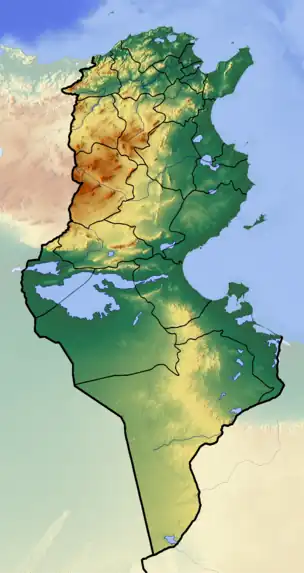| Chenini Member | |
|---|---|
| Stratigraphic range: Late Aptian-Early Albian ~ | |
| Type | Member |
| Unit of | Aïn el Guettar Formation |
| Underlies | Oum ed Diab Member |
| Overlies | Douiret Formation |
| Lithology | |
| Primary | Sandstone |
| Other | Conglomerate, mudstone |
| Location | |
| Location | Sahara Desert |
| Coordinates | 33°12′N 10°18′E / 33.2°N 10.3°E |
| Approximate paleocoordinates | 15°54′N 10°18′E / 15.9°N 10.3°E |
| Region | Tataouine |
| Country | |
| Type section | |
| Named for | Chenini |
 Chenini Member (Tunisia) | |
The Chenini Member is a geological member of the Ain el Guettar Formation in Tunisia, whose strata date back to the Late Aptian to Early Albian stages of the Cretaceous period.[1][2] The lithology consists of coarse sandstones with occasional conglomerates and mudstones.[3] Dinosaur remains are among the fossils that have been recovered from the formation.[4]
Vertebrate paleofauna
The Chenini Member during the Early Cretaceous period was a marsh-like habitat with swamps and plenty of water. The most famous dinosaur discoveries made here include Carcharodontosaurus and Spinosaurus.
- Carcharodontosaurus saharicus[4]
- Spinosaurus cf. aegyptiacus[5]
- Sauropod indet[4]
- Iguanodont indet[4]
- Ornithocheiridae indet[6]
See also
References
- ↑ Bateun el Hmaima at Fossilworks.org
- ↑ Bir Miteur, RH 45 at Fossilworks.org
- ↑ Benton, Michael J.; Bouaziz, Samir; Buffetaut, Eric; Martill, David; Ouaja, Mohamed; Soussi, Mohamed; Trueman, Clive (April 2000). "Dinosaurs and other fossil vertebrates from fluvial deposits in the Lower Cretaceous of southern Tunisia" (PDF). Palaeogeography, Palaeoclimatology, Palaeoecology. 157 (3–4): 227–246. doi:10.1016/s0031-0182(99)00167-4. ISSN 0031-0182.
- 1 2 3 4 Weishampel, David B; et al. (2004). "Dinosaur distribution (Early Cretaceous, Africa)." In: Weishampel, David B.; Dodson, Peter; and Osmólska, Halszka (eds.): The Dinosauria, 2nd, Berkeley: University of California Press. Pp. 571-573. ISBN 0-520-24209-2.
- ↑ Buffetaut, E & Ouaja, M (2002) A new specimen of Spinosaurus (Dinosauria, Theropoda) from the Lower Cretaceous of Tunisia, with remarks on the evolutionary history of the Spinosauridae. Bulletin de la Société Géologique de France 173: 415–421. doi:10.2113/173.5.415
- ↑ BENTON, M. J., BOUAZIZ, S., BUFFETAUT, E., MARTILL, D. M., OUAJA, M., SOUSSI, M. & TRUEMAN, C. (2000): Dinosaurs and other fossil vertebrates from fluvial deposits in the Lower Cretaceous of southern Tunisia. Palaeogeography, Palaeoclimatology, Palaeoecology, 157: 227–246.
Further reading
- S. Bouaziz, É. Buffetaut, M. Ghanmi, J.-J. Jaeger, M. Martin, J.-M. Mazin, and H. Tong. 1988. Nouvelles découvertes de vertébrés fossiles dans l'Albien du sud tunisien [New discoveries of fossil vertebrates in the Albian of southern Tunisia]. Bulletin de la Société Géologique de France, 8e série 4(2):335-339
- J. Le Loeuff, É. Buffetaut, G. Cuny, Y. Laurent, M. Ouaja, C. Souillat, D. Srarfi and H. Tong. 2000. Mesozoic continental vertebrates of Tunisia. 5th European Workshop on Vertebrate Palaeontology, Staatliches Museum für Naturkunde, Geowissenschaften Abteilung. Program. Abstracts. Excursion Guides 45
This article is issued from Wikipedia. The text is licensed under Creative Commons - Attribution - Sharealike. Additional terms may apply for the media files.